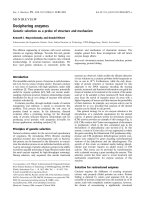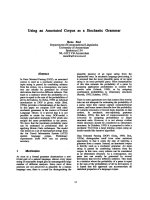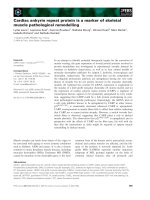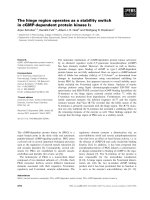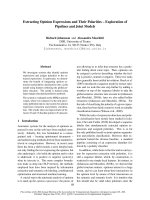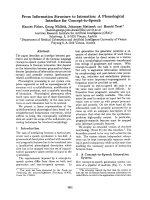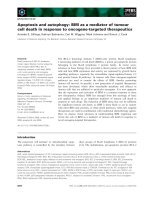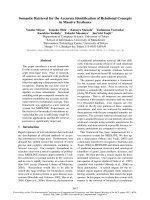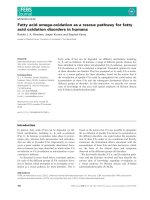Báo cáo khoa học: " Bench-to-bedside review: Endotoxin tolerance as a model of leukocyte reprogramming in sepsis" pot
Bạn đang xem bản rút gọn của tài liệu. Xem và tải ngay bản đầy đủ của tài liệu tại đây (326.08 KB, 8 trang )
Page 1 of 8
(page number not for citation purposes)
Available online />Abstract
Endotoxin tolerance is defined as a reduced responsiveness to a
lipopolysaccharide (LPS) challenge following a first encounter with
endotoxin. Endotoxin tolerance protects against a lethal challenge
of LPS and prevents infection and ischemia-reperfusion damage.
Endotoxin tolerance is paralleled by a dramatic reduction of tumor
necrosis factor (TNF) production and some other cytokines in
response to LPS. Endotoxin tolerance involves the participation of
macrophages and mediators, such as glucocorticoids, prosta-
glandins, IL-10, and transforming growth factor-β. Endotoxin
tolerance is accompanied by the up-regulation of inhibitory
molecules that down-regulate the Toll-like receptor (TLR)4-
dependent signaling pathway. Cross-tolerance between LPS and
other TLR specific ligands, as well as IL-1 and TNF, has been
regularly reported. A similar loss of LPS reactivity has been
repeatedly reported in circulating leukocytes of septic patients and
in patients with non-infectious systemic inflammation response
syndrome (SIRS). Studies on cellular signaling within leukocytes
from septic and SIRS patients reveal numerous alterations
reminiscent of those observed in endotoxin tolerant cells. However,
altered responsiveness to LPS of leukocytes from sepsis and SIRS
patients is not synonymous with a global down-regulation of
cellular reactivity. The term ‘cellular reprogramming’, which has
been proposed to qualify the process of endotoxin tolerance,
defines well the immune status of circulating leukocytes in septic
and SIRS patients.
In vivo
endotoxin tolerance
Paul Beeson first reported endotoxin tolerance in 1946 [1] as
the abolition of the fever response of rabbits undergoing
repeated daily injection of the same dose of typhoid vaccine.
Later, it was shown that plasma of a tolerant rabbit could
passively transfer tolerance to pyrogenicity of bacterial
endotoxin to another animal [2]. In human volunteers, it was
shown that inoculation of live Salmonella typhosa led to a
reduced fever in response to endotoxin or killed bacteria
compared to before infection [3]. Interestingly, a similar
observation was reported with volunteers inoculated with
Plasmodium cynomolgi by mosquito bites [4], suggesting
that cross-tolerization between different stimuli could occur.
In addition to human volunteers, reduced fever to endotoxin
or killed bacteria was reported in different infections, such as
in patients with pyelonephritis [5], in patients convalescent
from typhoid and paratyphoid fever [6], and in patients
recovering from malaria [7].
Not only can a pretreatment with endotoxin reduce
subsequent lipopolysaccharide (LPS)-induced fever in
rabbits, it also prevents LPS-induced lethality [8]. In mice,
even when LPS-induced lethality was dramatically enhanced
by galactosamine treatment, LPS tolerization could prevent
mortality [9]. By specific cell transfer from LPS-resistant to
LPS-sensitive mice, Freudenberg and Galanos [9] elegantly
demonstrated the role of macrophages in the induction of
endotoxin tolerance in vivo.
Endotoxin tolerance and cytokine production
Tumor necrosis factor (TNF) is most probably the best marker
of endotoxin tolerance as assessed by its dramatically
reduced production following an LPS challenge in tolerized
animals, in contrast to its sharp and fast peak in response to a
first injection of LPS [10]. Interestingly, not all cytokines
behave similarly. In mouse models of endotoxin tolerance,
IL-6 and IFN-γ released in the circulation following an LPS
challenge are also dramatically blunted, whereas this is not
the case for IL-12p70, and the chemokines KC and MCP-1,
the circulating levels of which were reduced but not as much
as TNF and the previously mentioned cytokines [11]. In
contrast, levels of IL-1β and IL-18 were maintained
independently of the tolerization process. In humans,
induction of tolerance by monophosphoryl lipid A led to a
reduction of circulating TNF, IL-6 and IL-8 in response to a
subsequent LPS challenge [12].
Review
Bench-to-bedside review: Endotoxin tolerance as a model of
leukocyte reprogramming in sepsis
Jean-Marc Cavaillon and Minou Adib-Conquy
Cytokines and Inflammation Unit, Institut Pasteur, rue Dr Roux, 75015 Paris, France
Corresponding author: Jean-Marc Cavaillon,
Published: 13 October 2006 Critical Care 2006, 10:233 (doi:10.1186/cc5055)
This article is online at />© 2006 BioMed Central Ltd
IFN = interferon; IL = interleukin; IRAK = IL-1 receptor associated kinase; LPS = lipopolysaccharide; MyD = myeloid differentiation; NF-κB =
nuclear factor-kappa B; PBMC = peripheral blood mononuclear cell; RCA = resuscitated after cardiac arrest; SIGIRR = single immunoglobulin
IL-1R-related molecule; SIRS = systemic inflammation response syndrome; SOCS = suppressor of cytokine signaling; TGF = transforming growth
factor; TLR = Toll-like receptor; TNF = tumor necrosis factor; Tollip = Toll interacting protein; TRAF = TNF receptor associated factor.
Page 2 of 8
(page number not for citation purposes)
Critical Care Vol 10 No 5 Cavaillon and Adib-Conquy
In vitro pre-treatment of macrophage cell lines with LPS, as
well as freshly isolated macrophages and monocytes,
rendered the cells hyporeactive to a second LPS stimulus,
particularly in terms of cytokine production. In vitro tolerization
of human monocytes could be partially mimicked by IL-1, IL-10
or TGFβ pre-treatment [13], and the use of anti-IL-10 or anti-
TGFβ antibodies during the step of tolerization could prevent
the phenomenon [14]. Although IL-10 contributes to
endotoxin tolerance, its presence is dispensable as in vivo
tolerization could be achieved in IL-10 deficient mice [15].
Endotoxin tolerance and resistance to
inflammatory process or infection
It is worth recalling that endotoxin tolerance has been asso-
ciated with increased resistance and protection against tissue
injuries and even mortality in models such as infected thermal
injury [16], hepatic ischemia/reperfusion [17], renal ischemia/
reperfusion [18], coronary occlusion [19], or hemorrhagic
shock [20]. All these increased resistances to stressful
situations further illustrate that endotoxin tolerance is far more
than a single altered inflammatory responsiveness to LPS.
In contrast, some studies suggested that the induction of
endotoxin tolerance might impair resistance to infectious
processes. For example, a reduced level of IFN was reported
in animals pretreated with LPS and further challenged with
Newcastle disease virus [21]. Moreover, a reduced
leishmanicidal activity was observed after pre-exposure of
macrophages to LPS [22], and an impaired lung clearance of
Pseudomonas aeruginosa was shown after LPS exposure
[23]. Recent investigation with other infectious models using
either Cryptococcus neoformans [24] or Salmonella
enteritica [25] established that LPS tolerant mice had an
increased resistance to fungal or bacterial infection,
associated with a reduced burden of pathogens within the
tissues. Based upon experiments combining pentoxifylline
and LPS pretreatment [24], one can postulate that the boost
of TNF, among other cytokines, during the first stimulation by
LPS, later increased the resistance of the animals to the
infectious process. This is in agreement with the protective
role of inflammatory cytokines regularly reported since the
1980s. Accordingly, it is difficult to assume that endotoxin
tolerance per se is directly linked to the increased
susceptibility of systemic inflammation response syndrome
(SIRS) patients to nosocomial infections. Indeed, leukocytes
from sepsis and SIRS patients also display altered antigen
presentation, direct microbicidal activity, and oxidative burst.
Leukocyte reprogramming in sepsis and
systemic inflammatory response syndrome
An altered responsiveness of circulating human monocytes
has been regularly reported in sepsis patients. IL-1α, IL-1β,
IL-6, and TNF production upon ex vivo activation of patients’
monocytes were significantly reduced in response to LPS
[26]. Normal reactivity was never restored in non-surviving
patients in contrast to those who recovered. This altered ex
vivo cytokine production was reproduced in human
volunteers receiving an injection of LPS [27].
Altered
ex vivo
cytokine production is not a generalized
phenomenon
The reduction of the capacity of circulating leukocytes to
produce cytokine depends on several parameters. The
change of monocyte reactivity is a reflection of subtle
modifications that differ depending upon the nature of the
stress. For example, in patients undergoing major surgery,
two days post-surgery, the ex vivo production of TNF in
response to LPS was never reported to be reduced [28]. In
contrast, trauma patients displayed a long lasting hypo-
reactivity several days after their admission [29]. It is possible
that the use of anesthetic drugs during surgery may limit the
cell reprogramming following surgical injury, in contrast to
what happens in patients after trauma or burn. If so, it would
imply that neuromediators contribute to control cellular
reprogramming.
Many experiments assessing leukocyte hyporeactivity were
performed in whole blood assays, and are difficult to interpret.
First, some cytokines can be produced both by mononuclear
and by polymorphonuclear cells present in whole blood
samples (for example, IL-1ra), and the responsiveness of
each individual population may be differently affected by the
insult. This may explain why, in sepsis, the analysis of LPS-
induced IL-1ra performed in whole blood displayed an
enhanced release compared to healthy controls [30] while
that produced by isolated neutrophils was reduced [31].
Second, the presence of immunosuppressive factors within
the plasma may play an inhibitory role during the ex vivo
culture and may mask or influence the individual behavior of
leukocytes, once isolated [32,33]. For example, in sepsis, ex
vivo induction of TNF, IL-6 and IL-10 by heat-killed
Escherichia coli was shown to be reduced in whole blood
compared to healthy controls, whereas no difference was
noticed with isolated monocytes [34,35]. Despite this
possibility, it is worth mentioning that, in trauma patients,
numerous whole blood cultures revealed an enhanced
release of cytokines in response to different agonists.
Monocytes from septic patients have a diminished capacity to
release TNFα, IL-1α, IL-1β, IL-6, and IL-12 [30,36], whereas
this is not the case for IL-1ra [30], granulocyte colony
stimulatign factor [37] and macrophage migration inhibitory
factor [38]. We recently observed an enhanced production of
IL-10 by monocytes from septic patients in response to both
LPS and Pam3CysSK4 [35]. An enhanced or unchanged IL-
10 production was observed with circulating leukocytes of
patients after surgery [39], trauma [29], and in resuscitated
patients after cardiac arrest (RCA) [40]. In sepsis there are
controversial reports [41,42]. The fact that, after LPS-
triggering, monocytes can display a reduced production of
TNF and an unaltered or even enhanced production of IL-10,
illustrates that monocytes can still sense LPS, but that the
Page 3 of 8
(page number not for citation purposes)
intracellular signaling has been modified to limit the
production of pro-inflammatory cytokines and to maintain or
to favor that of anti-inflammatory ones.
There are still few studies that have investigated the
responsiveness of circulating leukocytes of SIRS patients to
agonists other than LPS. Recently, we showed in sepsis a
significantly reduced reactivity of monocytes to Pam3CysSK4,
a specific synthetic Toll-like receptor (TLR)2 agonist,
compared to healthy controls. In contrast, the production of
TNF induced by a TLR2 ligand was similar to that of healthy
controls in RCA and trauma patients [35]. There are still too
few studies with specific TLR9 ligands, and with IL-1 and
TNF as stimulating agents [29] to conceive a general idea of
the nature of the responsiveness to these specific activators.
Cross-tolerance has been regularly reported in experimental
models of endotoxin tolerance between LPS and other TLR
ligands. However, recent investigations suggest that the
specificity of TLR agonists may influence the observation of
cross-tolerance, since highly purified LPS (TLR4 ligand) did
not tolerize macrophages to Pam3CysSK4 (TLR2 ligand)
[43]. Revisiting the concept of cross-tolerance with Gram-
positive bacteria in a mouse model of endotoxin tolerance, we
showed that the phenomenon was only transient, especially
in the blood compartment [44]. Although the use of highly
specific TLR agonists is useful to further understand the
alteration of specific signaling pathways within cells from
SIRS patients, the response to whole bacteria may represent
a more relevant and physiological approach to monitor the
immune status. Many reports showed that leukocytes from
SIRS and sepsis patients remained responsive to whole
bacteria. Cells from SIRS patients normally responded to
heat-killed Staphylococcus aureus and Streptococcus
pyogenes [29]. These observations are in agreement with
previous reports in sepsis performed with P. aeruginosa [41]
and Salmonella typhimurium [45], and others in non-
infectious SIRS with S. aureus [29,40,46]; they differ from
other observations that showed in sepsis a reduced TNF
production in response to S. aureus and E. coli [34,47].
Mechanisms of leukocyte reprogramming
Desensitizing agents in plasma
The presence of deactivating or immunosuppressive agents
within the blood stream may contribute to the hyporeactivity
of circulating leukocytes. In the late 1970s, it was reported
that sera of burn patients were able to suppress the
proliferative response of normal cells [48]. Prins and
colleagues [49] showed that sera from septic patients had
the capacity to down-regulate the TNF production by
activated monocytes from healthy donors, The fact that
‘septic plasma’ behaves as an immunosuppressive milieu [32]
is illustrated in human volunteers by the capacity of endotoxin
to induce plasma inhibitors [50]. Most interestingly, in septic
patients, this suppressive effect was significantly reduced
after passage of plasma through a resin and after incubation
with anti-IL-10 antibodies [51]. IL-10 was identified as a
major functional deactivator of monocytes in human septic
shock plasma [52]. However, we demonstrated that IL-10
was not sufficient to explain the observed dysregulation that
occurs in septic patients [53] and IL-10 knock out mice can
still be tolerized to endotoxin [15]. TGFβ was also shown in
animal models of hemorrhagic shock or sepsis to be the
causative agent of the depressed splenocyte responsiveness
[54]. Monocytes from immunocompromized trauma patients
seem to be a source of TGFβ [55], and TGFβ released by
apoptotic T cells contributes to this immunosuppressive
milieu [56]. In addition, there is accumulating evidence for a
strong interaction between components of the nervous and
the immune systems. Numerous neuromediators have been
shown to behave as immunosuppressors. Catecholamines,
found to be at higher concentrations in stressful situations
[57], suppress the activity of immuno-competent cells, inhibit
TNF production and favor IL-10 release. Alpha-melanocyte-
stimulating hormone also contributes to immunosuppression
by inducing IL-10 production by human monocytes [58]. In
addition, vasoactive intestinal peptide and pituitary adenylate
cyclase-activating polypeptide directly inhibit endotoxin
induced pro-inflammatory cytokine secretion [59]. SIRS is
also associated with an activation of the hypothalamus-
pituitary-adrenal axis, which leads to the release of
glucocorticoids, well known for their potent ability to limit
cytokine production [60]. Prostaglandins are produced
during sepsis and can also contribute to the down regulation
of cytokine production [61]. Finally, the levels of circulating
heat shock proteins are elevated in SIRS and sepsis patients
[62]. Since it has been shown that over-expression of heat
shock proteins can inhibit LPS induced production of
cytokines [63], one can postulate that they may play a role in
desensitizing circulating cells.
Endotoxin neutralizing molecules in plasma
When the cells from healthy controls were incubated with
plasma from non-infectious SIRS patients, a strong inhibition
of LPS-induced TNF production was observed, suggesting
that patients’ plasma contains inhibitory mediators [64]. In
contrast, SIRS plasma did not significantly affect the heat-
killed S. aureus-induced TNF production. SIRS plasma, which
contains high levels of sCD14 [65] and high levels of LPS-
binding protein [66], may be particularly inhibitory towards
the LPS-induced activation because of the presence of these
molecules, high concentrations of which are known to
specifically inhibit LPS. In addition, plasma lipoproteins are
also known to neutralize endotoxins [67], and Warren and
colleagues [68] have shown that LPS bound much more
rapidly to lipoprotein fractions in tolerant serum than in normal
serum. More recently, enhanced levels of ubiquitin, an 8.6 kDa
protein involved in intracellular function, have been found in
serum of sepsis and trauma patients and shown to specifically
inhibit TNF induction by LPS [69]. Altogether, these
observations may partially explain why LPS responsiveness is
specifically reduced in SIRS compared to other activators.
Available online />Nuclear factor-kappa B inhibition
Nuclear factor-kappa B (NF-κB) is critical for maximal
expression of many cytokines involved in the pathogenesis of
inflammation. Activation and regulation of NF-κB are tightly
controlled by a group of inhibitory proteins (IκB), which
maintain NF-κB in the cytoplasm of effector cells. Blackwell
and co-workers [70] investigated the role of NF-κB in the
mechanism of endotoxin tolerance in a rat alveolar macro-
phage cell line. Tolerance, monitored by cytokine production,
was associated with an impaired activation of NF-κB and a
depletion of both p65 and p50 forms. This study suggested
that endotoxin tolerance may be mediated by limiting the
amount of NF-κB available for activation and, thus, inhibiting
transcription of NF-κB-dependent genes. On the other hand,
Ziegler-Heitbrock and colleagues [71] demonstrated that
endotoxin tolerance in a monocytic cell line was associated
with an increase of the inactive p50 homodimer of NF-κB and
a decrease of the p50p65 active heterodimer. We undertook
a study on NF-κB expression in mononuclear cells of patients
with severe sepsis or major trauma. Subsequent to an in vitro
stimulation of peripheral blood mononuclear cells (PBMCs)
with LPS, the expression of both p65p50 and p50p50 was
low in survivors of sepsis, while non-survivors of sepsis
showed a predominance of the inactive homodimer and a low
p65p50/p50p50 ratio when compared to controls [72]. In
the latter group of patients there was a reverse correlation
between plasma IL-10 levels and the p65p50/p50p50 ratio
after in vitro LPS stimulation. The reduced expression of
nuclear NF-κB was not due to its inhibition by IκBα since very
low expression of IκBα and low levels of p65 and p50 were
found in the cytoplasm of PBMCs from sepsis patients when
compared to controls. These results demonstrate that, upon
LPS activation, PBMCs of SIRS patients show patterns of
NF-κB expression that resemble those reported during LPS
tolerance: a global down-regulation of NF-κB in survivors of
sepsis, or the presence of large amounts of the inactive
homodimer in the non-survivors. In trauma patients, we
observed a long-term reduction of both p65/p50 hetero-
dimers and p50/p50 homodimers and a reduced p65p50/
p50p50 ratio after LPS stimulation in vitro [73].
Down regulation of TLR-associated signaling pathways
Still very few studies have addressed in humans the link
between the altered responsiveness to LPS of monocytes of
sepsis and SIRS patients and the modification of the TLR4
signaling pathways. In the past few years, numerous
intracellular molecules that negatively regulate LPS-activated
signaling pathways have been discovered (Figure 1). IL-1
receptor associated kinase (IRAK)-M prevents the
dissociation of IRAK-1 and IRAK-4 from myeloid differentia-
tion (MyD)88 and the formation of IRAK-TNF receptor
associated factor (TRAF)6 complexes, and is a negative
regulator of TLR signaling. Interestingly, endotoxin tolerance
is significantly reduced in IRAK-M deficient mice [74]. It has
been recently reported that monocytes from septic patients,
when stimulated with LPS ex vivo, express IRAK-M mRNA
more rapidly than cells from healthy donors [75]. Phospha-
tidylinositol 3-kinase behaves as an early inhibitor of TLR
signaling [76]. Learn and colleagues [77] reported in septic
patients that the repressed production of IL-1β and the
selective elevation of the secreted form of IL-1Ra in response
to LPS were linked to a probably altered IRAK-dependent
signaling pathway and a maintained efficient phosphatidyl-
inositol 3-kinase-dependent signaling pathway. Toll inter-
acting protein (Tollip), an adapter protein found to associate
with the cytoplasmic TIR domain of IL-1R, TLR2 and TLR4,
potently suppresses the activity of IRAK after TLR activation
[78]. A splice variant of MyD88, termed MyD88 short
(MyD88s), induced upon LPS activation, is defective in its
ability to induce IRAK phosphorylation and behaves as
dominant-negative inhibitor [79]. Single immunoglobulin
IL-1R-related molecule (SIGIRR), a member of the TLR/IL-1R
superfamily, is a negative modulator of the signaling induced
by IL-1 or TLR4 ligands in other cells than macrophages [80].
Suppressor of cytokine signaling (SOCS)-1, promptly induced
in macrophages upon LPS stimulation, is a negative regulator
molecule of the JAK-STAT signal cascade. Interestingly,
endotoxin tolerance cannot be observed in mice deficient for
SOCS-1 [81]. We recently investigated the Tollip, SOCS1,
MyD88s and SIGIRR regulators in sepsis and RCA patients.
In monocytes of sepsis patients, we found that the mRNA
expression of Tollip and SOCS1 was unchanged, while that
of MyD88s and SIGIRR was significantly enhanced com-
pared to healthy controls [35]. Other molecules involved in
down-regulating the TLR4-induced MyD88-dependent
signaling pathway would be worth investigating. In addition to
SIGIRR, two other surface receptors are known to down
regulate TLR4-signaling, namely RP105, which prevents
TLR4/MD2 activation [82], and ST2, which interacts with and
inhibits MyD88 and Mal/TIRAP [83]. Intracellular inhibitory
molecules include: Triad3A, which favors ubiquitynilation of
TLR4 and promotes its degradation via the proteosome [84];
Flightless I homolog, which interacts with MyD88 and
interferes with the formation of the TLR4-MyD88 complex
[85]; Monarch-1, which associates with IRAK-1, resulting in
the blockage of IRAK-1 hyperphosphorylation [86]; A20,
which removes ubiquitin moieties from the signaling molecule
TRAF6 [87]; SHIP, which is produced in response to TGFβ
exerting its inhibitory effects, primarily through the hydrolysis
of the phosphatidylinositol 3-kinase [88]; TRAF4, which
interacts and counteracts TRAF6 and TRIF molecules [89];
FLN29, which contains a TRAF-6-related zinc finger motif
suppressing NF-κB and mitogen-activated protein kinase
activation downstream of TRAF6 [90]; ABIN-3, which inhibits
NF-κB activation, downstream of TRAF6, but upstream of IKK
(Wullaert et al., personal communication); Dok-1 and Dok-2,
which are negative regulators of the Ras-Erk signaling
pathway [91]; DUSP1 [92] and MKP-1 [93], which control
p38 MAP kinase activation; RanGTPase, which reduces NF-
κB accumulation in the nucleus [94]; and Bcl-3, which is
induced by IL-10 and inhibits NF-κB binding onto its
promotor sites [95] (see Figure 1).
Critical Care Vol 10 No 5 Cavaillon and Adib-Conquy
Page 4 of 8
(page number not for citation purposes)
Alteration of immune status or physiological
adaptation?
Sepsis and non-infectious SIRS are associated with an
exacerbated production of cytokines, as assessed by their
presence in biological fluids [96]. The enhanced levels of
cytokines within the bloodstream reflect the presence of
activated or primed leukocytes within the different tissue
compartments [97]. The local enhanced inflammatory
response is a prerequisite to prevent infectious development
in tissues, but failure to properly down-regulate the
inflammatory process may lead to organ failure. The
diminished capacity of circulating monocytes to produce
cytokine upon in vitro activation displays similarities with the
endotoxin tolerance phenomenon. This may represent a
protective response against an overwhelming dysregulation
of the pro-inflammatory process [98]. In contrast to endotoxin
tolerance, which has been shown to enhance resistance to
infection, the observation of an altered immune status in
patients may favor an increased risk of subsequent
nosocomial infections. Other defects have been reported for
T cells, dendritic cells, as well as apoptosis that mainly affects
immune cells. However, monocyte hyporeactivity is not a
global phenomenon and some signaling pathways are
unaltered and allow the cells to respond normally to certain
stimuli. The terms anergy, immunodepression, or immuno-
paralysis are often used to qualify the immune status of
sepsis patients. However, the term ‘cellular reprogramming’,
previously proposed by Zhang and Morisson [99] to
characterize endotoxin tolerance, appears to be the most
appropriate one to define the events occurring among
circulating leukocytes during critical illness.
Competing interests
The authors declare that they have no competing interests.
Acknowledgements
The authors are deeply grateful to their colleagues in Intensive Care
Units, who, through the years, allowed their investigations, particularly Dr
Christophe Adrie, Prof. Djillali Annane, Dr Jean Carlet, Prof. Jean-François
Dhainaut, Dr Benoit Misset, Dr Pierre Moine, and Prof. Didier Payen. We
thank Prof. Michael Pinsky for his invitation to write this review.
Available online />Page 5 of 8
(page number not for citation purposes)
Figure 1
Inhibitory signals of the Toll-like receptor (TLR)4-induced MyD88-dependent signaling pathway. In addition to negative signals delivered by
cytokines, cell surface receptors and numerous intracellular molecules down-regulate the TLR4-dependent signaling pathways following its
activation by endotoxin (lipopolysaccharide (LPS)) (see text for further explanation). Small downwards and upwards arrows in squares indicate the
down- or up-regulation, respectively, of the compound observed in endotoxin tolerant cells. Framed names of inhibitors indicate their demonstrated
involvement in the endotoxin tolerance process. ABIN, A20 binding inhibitor of NF-κB activation; DUSP-1, dual specificity phosphatase 1; Erk,
extracellular signal-related kinase; HO-1, heme oxygenase-1; IκB, inhibitor of κB; IRAK, IL-1 receptor associated kinase; MAPK, mitogen-activated
protein kinase; MKP, MAPK phosphatase; MyD88, myeloid differentiation 88; NF-κB, nuclear factor-kappa B; pi3K, phosphatidylinositol 3-kinase;
SHIP, SH1-containing inositol-5′ phosphatase; SIGIRR, single immunoglobulin IL-1R-related molecule; SOCS, suppressor of cytokine signaling;
STAT, signal transducer and activator of transcription; TAK1, TGFβ activating kinase 1; TGF, transforming growth factor; Tollip, Toll interacting
protein; TRAF, TNF receptor associated factor.
References
1. Beeson PB: Development of tolerance to typhoid bacterial
pyrogen and its abolition by reticulo-endothelial blockade.
Proc Soc Exp Biol Med 1946, 61:248-250.
2. Freeman HH: Passive transfer of tolerance to pyrogenicity of
bacterial endotoxin. J Exp Med 1960, 111:453-463.
3. Greisman SE, Hornick RB, Wagner HN Jr, Woodward WE,
Woodward TE: The role of endotoxin during typhoid fever and
tularemia in man. J Clin Invest 1969, 48:613-629.
4. Rubenstein M, Mulholland JH, Jeffery GM, Wolf SM: Malaria
induced endotoxin tolerance. Proc Soc Exp Biol Med 1965,
118:283-287.
5. McCabe WR: Endotoxin tolerance. II Its occurrence in patients
with pyelonephritis. J Clin Invest 1963, 42:618-625.
6. Neva FA, Morgan HR: Tolerance to the action of endotoxin of
enteric bacilli in patients convalescent from typhoid and
paratyphoid fevers. J Lab Clin Med 1950, 35:911-922.
7. Heyman A, Beeson PB: Influence of various disease states
upon the febrile response to intravenous injection of typhoid
bacterial pyrogen. J Lab Clin Med 1949, 34:1400-1403.
8. Watson DW, Kim YB: Modification of host responses to bacte-
rial endotoxins. I specificity of pyrogenic tolerance and the
role of hypersensitivity in pyrogenicity, lethality and skin reac-
tivity. J Exp Med 1963, 118:425-446.
9. Freudenberg MA, Galanos C: Induction of tolerance to
lipopolysaccharide (LPS) -D-galactosamine lethality by pre-
treatment with LPS is mediated by macrophages. Infect
Immun 1988, 56:1352-1357.
10. Mathison JC, Virca GD, Wolfson E, Tobias PS, Glaser K, Ulevitch
RJ: Adaptation to bacterial lipopolysaccharide controls
lipopolysaccharide-induced tumor necrosis factor production
in rabbit macrophages. J Clin Invest 1990, 85:1108-1118.
11. Rayhane N, Fitting C, Cavaillon J-M: Dissociation of INFg from
IL-12 and IL-8 during endotoxin tolerance. J Endotoxin Res
1999, 5:319-324.
12. Astiz ME, Rackow EC, Still JG, Howell ST, Cato A, Von Eschen
KB, Ulrich JT, Rudbach JA, McMahon G, Vargas R, et al.: Pre-
treatment of normal humans with monophosphoryl lipid A
induces tolerance to endotoxin: a prospective double blind,
randomized, controlled trial. Crit Care Med 1995, 23:9-17.
13. Cavaillon JM, Pitton C, Fitting C: Endotoxin tolerance is not a
LPS-specific phenomenon: partial mimicry with IL-1, IL-10 and
TGFb. J Endotoxin Res 1994, 1:21-29.
14. Randow F, Syrbe U, Meisel C, Krausch D, Zuckermann H, Platzer
C, Volk H: Mechanism of endotoxin desensitization: involve-
ment of interleukin-10 and transforming growth factor-b. J
Exp Med 1995, 181:1887-1892.
15. Berg D, Kühn R, Rajewsky K, Müller W, Menon S, Davidson N,
Grünig G, Rennick D: Interleukin-10 is a central regulator of
the response to LPS in murine models of endotoxin shock
and the Shwartzman reaction but not endotoxin tolerance. J
Clin Invest. 1995, 96:2339-2347.
16. He W, Fong Y, Marano MA, Gershenwald JE, Yurt RW, Moldawer
LL, Lowry SF: Tolerance to endotoxin prevents mortality in
infected thermal injury: association with attenuated cytokine
responses. J Infect Dis 1992, 165:859-864.
17. Colletti LM, Remick DG, Campbell DA: LPS pretreatment pro-
tects from hepatic ischemia/reperfusion. J Surg Res 1994, 57:
337-343.
18. Heemann U, Szabo A, Hamar P, Müller V, Witzke O, Lutz J, Philipp T:
Lipopolysaccharide pretreatment protects from renal ischemia/
reperfusion injury. Possible connection to an interleukin-6
dependent pathway. Am J Pathol 2000, 156:287-293.
19. Eising GP, Mao L, Schmid-Schonbein GW, Engler RL, Ross J:
Effects of induced tolerance to bacterial lipopolysaccharide
on myocardial infarct size in rats. Cardiovasc Res 1996, 31:73-
81.
20. Ackerman M, Reuter M, Flohé S, Bahrami S, Redl H, Schade FU:
Cytokine synthesis in the liver of endotoxin-tolerant and
normal rats during hemorrhagic shock. J Endotoxin Res 2001,
7:105-112.
21. Youngner JS, Stinebring WR: Interferon appearance stimulated
by endotoxin bacteria or viruses in mice pre-treated with
Escherichia coli endotoxin or infected with Mycobacterium
tuberculosis. Nature 1965, 208:456-458.
22. Severn A, Xu D, Doyle J, Leal LM, O'Donnell CA, Brett SJ, Moss
DW, Liew FY: Pre-exposure of murine macrophages to
lipopolysaccharide inhibits the induction of nitric oxide syn-
thase and reduces leishmanicidal activity. Eur J Immunol
1993, 23:1711-1714.
23. Mason CM, Dobard E, Summer WR, Nelson S: Intraportal
lipopolysaccharide suppresses pulmonary antibacterial
defense mechanisms. J Infec Dis 1997, 176:1293-1302.
24. Rayhane N, Fitting C, Lortholary O, Dromer F, Cavaillon J-M:
Administration of endotoxin associated with lipopolysaccha-
ride tolerance protects mice against fungal infection. Infect
Immun 2000, 68:3748-3753.
25. Lehner MD, Ittner J, Bundschuh DS, N vR, Wendel A, Hartung T:
Improved innate immunity of endotoxin-tolerant mice
increases resistance to Salmonella enterica serovar
typhimurium infection despite attenuated cytokine response.
Infect Immun 2001, 69:463-471.
26. Muñoz C, Carlet J, Fitting C, Misset B, Bleriot JP, Cavaillon JM:
Dysregulation of in vitro cytokine production by monocytes
during sepsis. J Clin Invest 1991, 88:1747-1754.
27. Granowitz EV, Porat R, Mier JW, Orencole SF, Kaplanski G,
Lynch EA, Ye K, Vannier E, Wolff SM, Dinarello CA: Intravenous
endotoxin suppresses the cytokine response of peripheral
blood mononuclear cells of healthy humans. J Immunol 1993,
151:1637-1645.
28. Cabié A, Fitting C, Farkas J-C, Laurian C, Cormier J-M, Carlet J,
Cavaillon J-M: Influence of surgery on in-vitro cytokine produc-
tion by human monocytes. Cytokine 1992, 4:576-580.
29. Adib-Conquy M, Moine P, Asehnoune K, Edouard A, Espevik T,
Miyake K, Werts C, J-M Cavaillon: Toll-like receptor-mediated
tumor necrosis factor and interleukin-10 production differ
during systemic inflammation. Am J Resp Crit Care Med 2003,
168:158-164.
30. Van Deuren M, Van Der Ven-Jongekrijg H, Demacker PNM, Bater-
link AKN, Van Dalen R, Sauerwein RW, Gallati H, Vannice J, van
Der Meer JWM: Differential expression of proinflammatory
cytokines and their inhibitors during the course of meningo-
coccal infections. J Infect Dis 1994, 169:157-161.
31. Marie C, Muret J, Fitting C, Payen D, Cavaillon J-M: IL-1 receptor
antagonist production during infectious and noninfectious
systemic inflammatory response syndrome. Crit Care Med
2000, 28:2277-2283.
32. Cavaillon J-M: “Septic Plasma”: an immunosuppressive milieu.
Am J Respir Crit Care Med 2002, 166:1417-1418.
33. Cavaillon J-M, Adib-Conquy M, Cloëz-Tayarani I, Fitting C:
Immunodepression in sepsis and SIRS assessed by ex vivo
cytokine production is not a generalized phenomenon : a
review. J Endotoxin Res 2001, 7:85-93.
34. Haupt W, Zirngibl H, Riese J, Stehr A, Linde HJ, Hohenberger W:
Depression of tumor necrosis factor-alpha, interleukin-6, and
interleukin-10 production: a reaction to the initial systemic
hyperactivation in septic shock. J Invest Surg 1997, 10:349-355.
35. Adib-Conquy M, Adrie C, Fitting C, Gattoliat O, Beyaert R, Cavail-
lon JM: Up-regulation of MyD88s and SIGIRR, molecules
inhibiting Toll-like receptor signaling, in monocytes from
septic patients. Crit Care Med 2006, 34:2377-2385.
36. Muñoz C, Misset B, Fitting C, Bleriot JP, Carlet J, Cavaillon J-M:
Dissociation between plasma and monocyte-associated
cytokines during sepsis. Eur J Immunol 1991, 21:2177-2184.
37. Weiss M, Fischer G, Barth E, Boneberg E, Schneider EM, Georgi-
eff M, Hartung T: Dissociation of LPS-induced monocytic ex
vivo production of granulocyte colony-stimulating factor (G-
CSF) and TNF-alpha in patients with septic shock. Cytokine
2001, 13:51-54.
38. Maxime V, Fitting C, Annane D, Cavaillon J-M: Corticoids normal-
ize leukocyte production of macrophage migration inhibitory
factor in septic shock. J Infect Dis 2005, 191:138-144.
39. Hensler T, Hecker H, Heeg K, Heidecke CD, Bartels H, Barthlen
W, Wagner H, Siewert JR, Holzmann B: Distinct mechanism of
immunosuppression as a consequence of major surgery.
Infect Immun 1997, 65:2283-2291.
40. Adrie C, Adib-Conquy M, Laurent I, Monchi M, Vinsonneau C,
Fitting C, Fraisse F, Dinh-Xuan AT, Carli P, Spaulding C, et al.:
Successful cardiopulmonary resuscitation after cardiac arrest
as a “sepsis like” syndrome. Circulation 2002, 106:562-568.
41. Rigato O, Salomao R: Impaired production of interferon-
gamma and tumor necrosis factor-alpha but not of interleukin
10 in whole blood of patients with sepsis. Shock 2003, 19:
113-116.
Critical Care Vol 10 No 5 Cavaillon and Adib-Conquy
Page 6 of 8
(page number not for citation purposes)
42. Marchant A, Alegre M, Hakim A, Piérard G, Marécaux G, Friedman
G, De Groote D, Kahn R, Vincent J, Goldman M: Clinical and bio-
logical significance of interleukin-10 plasma levels in patients
with septic shock. J Clin Immunol 1995, 15:265-272.
43. Dobrovolskaia MA, Medvedev AE, Thomas KE, Cuesta N,
Toshchakov V, Ren T, Cody MJ, Michalek SM, Rice NR, Vogel SN:
Induction of in vitro reprogramming by Toll-like receptor
(TLR)2 and TLR4 agonists in murine macrophages: effects of
TLR “homotolerance” versus “heterotolerance” on NF-kappa B
signaling pathway components. J Immunol 2003, 170:508-519.
44. Fitting C, Dhawan S, Cavaillon JM: Compartmentalisation of
endotoxin tolerance. J Infect Dis 2004, 189:1295-1303.
45. Mitov IG, Kropec A, Benzing A, Just H, Garotta G, Galanos C,
Freudenberg M: Differential cytokine production in stimulated
blood cultures from intensive care patients with bacterial
infections. Infection 1997, 25:206-212.
46. Muret J, Marie C, Fitting C, Payen D, Cavaillon J-M: Ex vivo T-
lymphocyte derived cytokine production in SIRS patients is
influenced by experimental procedures. Shock 2000, 13:169-
174.
47. Wilhelm W, Grundmann U, Rensing H, Werth M, Langemeyer J,
Stracke C, Dhingra D, Bauer M: Monocyte deactivation in
severe human sepsis or following cardiopulmonary bypass.
Shock 2002, 17:354-360.
48. Constantian M: Association of sepsis with an immunosuppres-
sive polypeptide in the serum of burn patients. Ann Surg
1978, 188:209-215.
49. Prins JM, Kuijper EJ, Mevissen ML, Speelman P, van Deventer SJ:
Release of tumor necrosis factor alpha and interleukin 6
during antibiotic killing of Escherichia coli in whole blood:
influence of antibiotic class, antibiotic concentration, and
presence of septic serum. Infect Immun 1995, 63:2236-2242.
50. Spinas G, Bloesch D, Kaufmann M, Keller U, Dayer JM: Induction
of plasma inhibitors of interleukin 1 and TNF-alpha activity by
endotoxin administration to normal humans. Am J Physiol
1990, 259:R993-R997.
51. Ronco C, Brendolan A, Lonnemann G, Bellomo R, Piccinni P,
Digito A, Dan M, Irone M, La Greca G, Inguaggiato P, et al.: A
pilot study of coupled plasma filtration with adsorption in
septic shock. Crit Care Med 2002, 30:1250-1255.
52. Brandtzaeg P, Osnes L, Øvstebø R, Joø GB, Westwik AB, Kierulf
P: Net inflammatory capacity of human septic shock plasma
evaluated by a monocyte-based target cell assay: identifica-
tion of interleukin-10 as a major functional deactivator of
human monocytes. J Exp Med 1996, 184:51-60.
53. Marie C, Fitting C, Muret J, Payen D, Cavaillon J-M: Interleukin-8
production in whole blood assays: is interleukin-10 responsi-
ble for the downregulation observed in sepsis? Cytokine
2000, 12:55-61.
54. Ayala A, Knotts JB, Ertel W, Perrin MM, Morrison MH, Chaudry IH:
Role of interleukin 6 and transforming growth factor-beta in
the induction of depressed splenocyte responses following
sepsis. Arch Surg 1993, 128:89-94.
55. Miller-Graziano CL, Szabo G, Griffey K, Mehta B, Kodys K, Cata-
lano D: Role of elevated monocyte transforming growth factor
ββ
production in post-trauma immunosuppression. J Clin Immunol
1991, 11:95-102.
56. Chen W, Frank M, Jin W, Wahl S: TGF-beta released by apop-
totic T cells contributes to an immunosuppressive milieu.
Immunity 2001, 14:715-725.
57. Jones SB, Westfall MV, Sayeed MM: Plasma catecholamines
during E. coli bacteremia in conscious rats. Am J Physiol
1988, 254:R470-477.
58. Luger TA, Kalden DH, Scholzen TE, Brzoska T: A melanocyte
stimulating hormone as a mediator of tolerance induction.
Pathobiology 1999, 67:318-321.
59. Delgado M, Pozo D, Martinez C, Leceta J, Calvo JR, Ganea D,
Gomariz RP: Vasoactive intestinal peptide and pituitary adeny-
late cyclase-activating polypeptide inhibit endotoxin-induced
TNFa production by macrophages : in vitro and in vivo studies.
J Immunol 1999, 162:2358-2367.
60. Annane D, Cavaillon JM: Corticosteroids in sepsis: from bench
to bedside? Shock 2003, 20:197-207.
61. Choudhry MA, Ahmad S, Ahmed Z, Sayeed MM: Prostaglandin
E2 down-regulation of T cell IL-2 production is independent of
IL-10 during Gram negative sepsis. Immunol Lett 1999, 67:
125-130.
62. Njemini R, Lambert M, Demanet C, Mets T: Elevated serum
heat-shock protein 70 levels in patients with acute infection:
use of an optimized enzyme-linked immunosorbent assay.
Scand J Immunol 2003, 58:664-669.
63. Ding X, Fernandez-Prada C, Bhattacharjee A, Hoover D: Over-
expression of hsp-70 inhibits bacterial lipopolysaccharide-
induced production of cytokines in human monocyte-derived
macrophages. Cytokine 2001, 16:210-219.
64. Cavaillon JM, Adrie C, Fitting C, Adib-Conquy M: Endotoxin tol-
erance: is there a clinical relevance? J Endotoxin Res 2003, 9:
101-107.
65. Kitchens RL, Thompson PA, Viriyakosol S, O’Keefe GE, Munford
RS: Plasma CD14 decreases monocyte responses to LPS by
transferring cell-bound LPS to plasma lipoproteins. J Clin
Invest 2001, 108:485-493.
66. Vreugdenhil ACE, Snoeck AMP, van’t Veer C, Greve JWM,
Buurman WA: LPS-binding protein circulates in association
with apoB-containing lipoproteins and enhances endotoxin-
LDL/VLDL interaction. J Clin Invest 2001, 107:225-234.
67. Cavaillon JM, Fitting C, Haeffner-Cavaillon N, Kirsch SJ, Warren
HS: Cytokine response by monocytes and macrophages to
free and lipoprotein-bound lipopolysaccharide. Infect Immun
1990, 58:2375-2382.
68. Warren HS, Knights CV, Siber GR: Neutralization and lipopro-
tein binding of lipopolysaccharides in tolerant rabbit serum. J
Infect Dis 1986, 154:784-791.
69. Majetschak M, Krehmeier U, Bardenheuer M, Denz C, Quintel M,
Voggenreiter G, Obertacke U: Extracellular ubiquitin inhibits
the TNF-alpha response to endotoxin in peripheral blood
mononuclear cells and regulates endotoxin hyporesponsive-
ness in critical illness. Blood 2003, 101:1882-1890.
70. Blackwell TS, Blackwell TR, Christman JW: Induction of endo-
toxin tolerance depletes nuclear factor-kB and suppresses its
activation in rat alveolar macrophages. J Leuk Biol 1997, 62:
885-891.
71. Ziegler-Heitbrock HWL, Wedel A, Schraut W, Ströbel M, Wen-
delgass P, Sterndorf T, Bäuerle PA, Haas JG, Riethmüller G: Tol-
erance to lipopolysaccharide involves mobilization of nuclear
factor
κκ
B with predominance of p50 homodimers. J Biol Chem
1994, 269:17001-17004.
72. Adib-Conquy M, Adrie C, Moine P, Asehnoune K, Fitting C, Pinsky
MR, Dhainaut J-F, Cavaillon J-M: NF-
κκ
B expression in mononu-
clear cells of septic patients resembles that observed in LPS-
tolerance. Am J Respir Crit Care Med 2000, 162:1877-1883.
73. Adib-Conquy M, Asehnoune K, Moine P, Cavaillon J-M: Long
term impaired expression of nuclear factor-kB and IkBa in
peripheral blood mononuclear cells of patients with major
trauma. J Leuk Biol 2001, 70:30-38.
74. Kobayashi K, Hernandez LD, Galan JE, Janeway CAJ, Medzhitov
R, Flavell RA: IRAK-M is a negative regulator of Toll-like recep-
tor signaling. Cell 2002, 110:191-202.
75. Escoll P, del Fresno C, Garcia L, Valles G, Lendinez M, Arnalich F,
Lopez-Collazo E: Rapid up-regulation of IRAK-M expression
following a second endotoxin challenge in human monocytes
and in monocytes isolated from septic patients. Biochem
Biophys Res Commun 2003, 311:465-472.
76. Fukao T, Koyasu S: PI3K and negative regulation of TLR signal-
ing. Trends Immunol 2003, 24:358-363.
77. Learn CA, Boger MS, Li L, McCall CE: The phosphatidylinositol
3 kinase pathway selectively controls sIL-1ra not interleukin-
1
ββ
production in the septic leukocytes. J Biol Chem 2001,
276:20234-20239.
78. Zhang G, Ghosh S: Negative regulation of toll-like receptor-
mediated signaling by Tollip. J Biol Chem 2002, 277:7059-
7065.
79. Janssens S, Burns K, Tschopp J, Beyaert R: Regulation of inter-
leukin-1- and lipopolysaccharide-induced NF-kappaB activa-
tion by alternative splicing of MyD88. Curr Biol 2002, 12:
467-471.
80. Wald D, Qin J, Zhao Z, Qian Y, Naramura M, Tian L, Towne J,
Sims JE, Stark GR, Li X: SIGIRR, a negative regulator of Toll-
like receptor-interleukin 1 receptor signaling. Nat Immunol
2003, 4:920-927.
81. Nakagawa R, Naka T, Tsutsui H, Fujimoto M, Kimura A, Abe T,
Seki E, Sato S, Takeuchi O, Takeda K, et al.: SOCS-1 partici-
pates in negative regulation of LPS responses. Immunity 2002,
17:677-687.
Available online />Page 7 of 8
(page number not for citation purposes)
82. Divanovic S, Trompette A, Atabani SF, Madan R, Golenbock DT,
Visintin A, Finberg RW, Tarakhovsky A, Vogel SN, Belkaid Y, et
al.: Inhibition of TLR-4/MD-2 signaling by RP105/MD-1. J
Endotoxin Res 2005, 11:363-368.
83. Brint EK, Xu D, Liu H, Dunne A, McKenzie ANJ, O'Neill LAJ, Liew
FY: ST2 is an inhibitor of interleukin 1 receptor and toll-like
receptor 4 signaling and maintains endotoxin tolerance. Nat
Immunol 2004, 5:373-379.
84. Chuang TH, Ulevitch RJ: Triad3A, an E3 ubiquitin-protein ligase
regulating Toll-like receptors. Nat Immunol 2004, 5:495-502.
85. Wang T, Chuang TH, Ronni T, Gu S, Du YC, Cai H, Sun HQ, Yin
HL, Chen X: Flightless I homolog negatively modulates the
TLR pathway. J Immunol 2006, 176:1355-1362.
86. Williams KL, Lich JD, Duncan JA, Reed W, Rallabhandi P, Moore
C, Kurtz S, Coffield VM, Accavitti-Loper MA, Su L, et al.: The
CATERPILLER protein monarch-1 is an antagonist of toll-like
receptor-, tumor necrosis factor alpha-, and Mycobacterium
tuberculosis-induced pro-inflammatory signals. J Biol Chem
2005, 280:39914-39924.
87. Boone DL, Turer EE, Lee EG, Ahmad RC, Wheeler MT, Tsui C,
Hurley P, Chien M, Chai S, Hitotsumatsu O, et al.: The ubiquitin-
modifying enzyme A20 is required for termination of Toll-like
receptor responses. Nat Immunol 2004, 5:1052-1060.
88. Rauh MJ, Sly LM, Kalesnikoff J, Hughes MR, Cao LP, Lam V,
Krystal G: The role of SHIP1 in macrophage programming and
activation. Biochem Soc Trans 2004, 32:785-788.
89. Takeshita F, Ishii KJ, Kobiyama K, Kojima Y, Coban C, Sasaki S,
Ishii N, Klinman DM, Okuda K, Akira S, et al.: TRAF4 acts as a
silencer in TLR-mediated signaling through the association
with TRAF6 and TRIF. Eur J Immunol 2005, 35:2477-2485.
90. Mashima R, Saeki K, Aki D, Minoda Y, Takaki H, Sanada T,
Kobayashi T, Aburatani H, Yamanashi Y, Yoshimura A: FLN29, a
novel interferon- and LPS-inducible gene acting as a negative
regulator of toll-like receptor signaling. J Biol Chem 2005,
280:41289-41297.
91. Shinohara H, Inoue A, Toyama-Sorimachi N, Nagai Y, Yasuda T,
Suzuki H, Horai R, Iwakura Y, Yamamoto T, Karasuyama H, et al.:
Dok-1 and Dok-2 are negative regulators of lipopolysaccha-
ride-induced signaling. J Exp Med 2005, 201:333-339.
92. Hammer M, Mages J, Dietrich H, Servatius A, Howells N, Cato
AC, Lang R: Dual specificity phosphatase 1 (DUSP1) regu-
lates a subset of LPS-induced genes and protects mice from
lethal endotoxin shock. J Exp Med 2006, 203:15-20.
93. Zhao Q, Wang X, Nelin LD, Yao Y, Matta R, Manson ME, Baliga
RS, Meng X, Smith CV, Bauer JA, et al.: MAP kinase phos-
phatase 1 controls innate immune responses and suppresses
endotoxic shock. J Exp Med 2006, 203:131-140.
94. Zhao F, Yuan Q, Sultzer BM, Chung SW and Wong PM: The
involvement of Ran GTPase in lipopolysaccharide endotoxin-
induced responses. J Endotoxin Res 2001, 7:53-56.
95. Kuwert EK, Marcus I, Werner J, Iwand A, Thraenhart O: Some
experiences with human diploid cell strain-(HDCS) rabies
vaccine in pre- and post-exposure vaccinated humans. Dev
Biol Stand 1978, 40:79-88.
96. Cavaillon JM, Adib-Conquy M, Fitting C, Adrie C, Payen D:
Cytokine cascade in sepsis. Scand J Infect Dis 2003, 35:535-
544.
97. Cavaillon J, Annane D: Compartmentalization of the inflamma-
tory response in sepsis and SIRS. J Endotoxin Res 2006, in
press.
98. Munford RS, Pugin J: Normal response to injury prevent sys-
temic inflammation and can be immunosuppressive. Am J
Respir Crit Care Med 2001, 163:316-321.
99. Zhang X, Morrison DC: Lipopolysaccharide structure-function
relationship in activation versus reprogramming of mouse
peritoneal macrophages. J Leukoc Biol 1993, 54:444-450.
Critical Care Vol 10 No 5 Cavaillon and Adib-Conquy
Page 8 of 8
(page number not for citation purposes)
